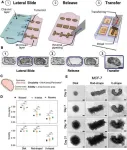The findings from researchers at Stanford and Harvard Universities offer the most definitive evidence to date that climate change is a big factor driving a global surge in the mosquito-borne disease. Countries in the Americas alone have recorded almost 12 million cases in 2024 compared to 4.6 million in 2023, and locally acquired infections have been reported in California and Florida. The study also carries warnings of even sharper increases to come.
“We looked at data on dengue incidence and climate variation across 21 countries in Asia and the Americas and found that there is a clear and direct relationship between rising temperatures and rising infections,” said Erin Mordecai, PhD, an infectious disease ecologist at Stanford’s Woods Institute for the Environment and the study’s senior author. “It’s evidence that climate change already has become a significant threat to human health and, for dengue in particular, our data suggests the impact could get much worse.”
While some dengue infections produce only mild symptoms, others cause excruciating joint pain (earning dengue the nickname “breakbone fever”), and severe cases can lead to bleeding complications and shock. There are no drugs to treat the disease and while there are two licensed dengue vaccines available, some dengue experts have pointed to challenges with both that could limit widespread adoption.
The study finds that amid dengue’s growing threat, moderating global warming by reducing emissions would also moderate climate impacts on dengue infections. The analysis shows that with sharp cuts in emissions, areas now on track to experience a 60% increase would instead see about a 40% rise in dengue infections between now and 2050. However, with global climate models predicting that temperatures will continue to increase even with large reductions in emissions, the researchers found that 17 of the 21 countries studied still would see climate-driven increases in dengue even under the most optimistic scenarios for carbon cuts.
Mordecai said the study was inspired by laboratory tests that found mosquitoes that carry dengue progressively churn out more and more virus as temperatures rise within a specific range. She said this temperature-induced bump starts at about 20 degrees Celsius (68 degrees Fahrenheit), then intensifies before peaking at about 28 or 29 C (about 82 F).
Her team then looked at 21 dengue endemic countries, including Brazil, Peru, Mexico, Colombia, Vietnam and Cambodia, which regularly collect data on infection rates. They also looked at other factors that can affect dengue infection rates — like rainfall patterns, seasonal changes, virus types, economic shocks and population density — in order to isolate whether there was a distinct temperature effect.
Mordecai said that dengue-endemic areas that are just now entering that 20 C to 29 C sweet-spot for virus transmission — parts of Peru, Mexico, Bolivia and Brazil — could face the biggest future risks, with infections over the next few decades rising 150% to 200%.
Meanwhile, the study found that areas already on the high end of the temperature range, like southern Vietnam, will experience little additional climate impacts and potentially a minor decrease. Overall, the analysis revealed that there are at least 257 million people now living in places where climate warming could cause dengue incidence to double in the next 25 years.
Mordecai said the study probably underestimates the climate-related dengue threat. That’s because researchers were unable to predict potential climate impacts on dengue-endemic areas that have not consistently tracked infections, which includes large parts of sub-Saharan Africa and South Asia. Also, Mordecai said they were unable to quantify future impacts for areas like the southern regions of the continental United States, where dengue is just starting to emerge as a local threat. “But as more and more of the U.S. moves into that optimal temperature range for dengue, the number of locally acquired infections will likely rise, though it’s too early to say how that will affect the global burden,” she said.
A Possible Solution: A Second Study Credits Common Bacteria with Protecting Brazilian City from Dengue Storm
With climate change acting as an accelerant fueling dengue’s surge, new findings presented at the ASTMH Annual Meeting provide some of the best evidence to date that releasing mosquitoes that carry a common bacteria called Wolbachia may offer a powerful tool to fend off intense outbreaks of the disease.
The study by researchers from the World Mosquito Program found that in 2024, as Brazil battled its largest dengue outbreak on record, there was only a small rise in Niterói, a city of half a million people close to Rio de Janeiro. The study credits the fact that five years ago, a partnership between the World Mosquito Program and Brazil’s Ministry of Health blanketed three-quarters of Niterói with mosquitoes infected with Wolbachia, a naturally occurring bacteria that has been shown to inhibit a mosquito’s ability to transmit dengue and other viruses. Deployments into the remaining areas were completed in May 2023.
“We already saw infections essentially flatline in Niterói after the Wolbachia deployment, and while there was a small increase in 2024, the caseload was still 90% lower than before the deployment — and nothing like what was happening in the rest of Brazil,” said Katie Anders, PhD, director of impact assessment at the World Mosquito Program, which has been leading a global effort to fight dengue with Wolbachia-infected mosquitoes. “The fact that Wolbachia has sustained itself in the mosquito population for years now and remained effective during a record year for dengue outbreaks shows that Wolbachia can provide long-term protection for communities against the increasingly frequent surges in dengue that we’re seeing globally.”
Anders said that since Wolbachia has been rolled out across Niterói, dengue incidence has dropped to an average of 84 cases per 100,000 people per year, compared to an average rate of 913 cases per 100,000 people per year in the 10 years pre-Wolbachia. The 1,736 dengue cases reported in Niterói from January to June 2024 represent a rate of 336 per 100,000 in 2024. That’s compared to a rate of 3,121 nationwide and 1,816 in Rio de Janeiro state during the same period. Overall, in 2024, Brazil has recorded 9.6 million dengue cases — more than twice as many as in 2023 — and 5,300 dengue-related deaths.
Other trials spearheaded by the World Mosquito Program, including large-scale releases in urban areas of Colombia and Indonesia, have reported significant reductions in dengue. They also have shown that Wolbachia is safe for humans, animals and the surrounding environment. But Anders said the protective effect documented in Niterói stands out for occurring amid such an intense wave of disease.
“In Brazil, we’re in the process of moving past Wolbachia as an experimental measure to its use as a cornerstone of dengue control,” said Luciano Moreira, PhD, the World Mosquito Program project lead in Brazil. “We’ve partnered with the Brazilian government to build a Wolbachia mosquito production facility that will enable deployment in multiple cities simultaneously — with the goal of protecting many millions of people.”
Anders noted that the production facility in Brazil is a significant step because one the biggest barriers to using Wolbachia on a large scale is that it requires releasing a large number of infected mosquitoes to spread the bacteria into the local mosquito population. She also said that governments and donors must be willing to invest with an understanding that Wolbachia is a preventative measure, not a tool for combating an ongoing outbreak — it requires a couple of years to implement and reach full effectiveness.
However, Wolbachia-infected mosquitoes transmit the bacteria to their offspring, which, according to Anders, means its protective effect could persist in a local population for many years. She said that evidence from the site of a 2011 release of Wolbachia-infected mosquitoes in Northern Australia showed the bacteria was still present in 90% of the local mosquito population more than 10 years after releases finished.
###
About the American Society of Tropical Medicine and Hygiene
The American Society of Tropical Medicine and Hygiene, founded in 1903, is the largest international scientific organization of experts dedicated to reducing the worldwide burden of tropical infectious diseases and improving global health. It accomplishes this through generating and sharing scientific evidence, informing health policies and practices, fostering career development, recognizing excellence, and advocating for investment in tropical medicine/global health research. For more information, visit astmh.org.
END

